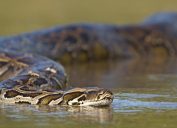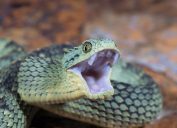Invasive 25-Foot Long Anacondas May Be Breeding in the U.S., Scientists Warn
Researchers are discovering more giant snake species in the South.
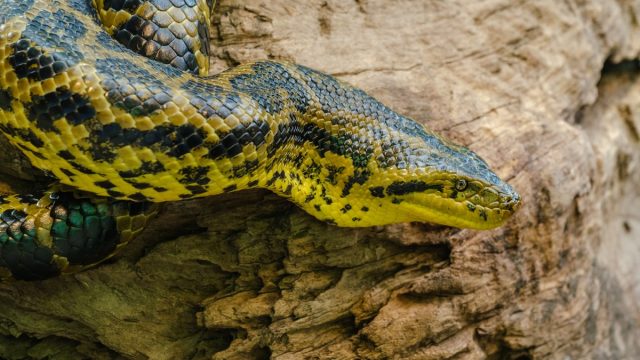
From scorpions crawling through the deserts of Arizona to wolf packs traveling throughout Washington, the U.S. is home to all kinds of dangerous animals. But for many of us, the creepy crawler we're most concerned with encountering is a snake. These creatures can find their way to your yard, or even crawl into your car. And while most won't cause you trouble, some can defend themselves with deadly bites. Now, scientists are warning that it's not just native species we need to be concerned about, as invasive snakes are spreading in the U.S. Read on to find out why some think 25-foot long anacondas may be breeding here.
RELATED: Giraffe-Sized Python Found in the U.S.—Why They're Unstoppable.
Invasive 200-pound pythons have been spreading in the U.S.
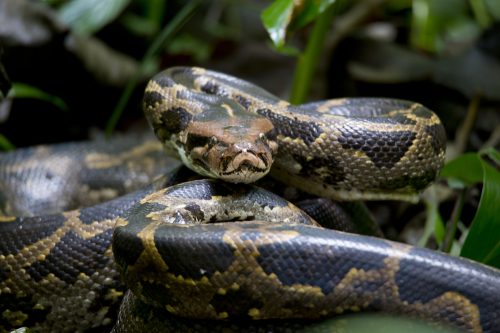
Back in February, scientists from the U.S. Geological Survey (USGS) released a report warning about a troubling development: An invasive species of Burmese pythons has started increasing in number throughout the state of Florida, and spreading into new areas.
"Burmese pythons were confirmed to have an established breeding population in Everglades National Park in 2000," the scientists explained. "The population has since expanded and now occupies much of southern Florida. They consume a wide range of animals and have altered the food web and ecosystems across the Greater Everglades."
The USGS researchers said that some of the Burmese pythons found in Floria recently have weighed over 200 pounds and measured longer than 15 feet. Since then, a record-breaking python measuring 19 feet was found.
Their massive size has likely aided their predator behavior, as evidence by at least 76 prey species, including mammals, birds, and even alligators, that have been found in the digestive tracts of these snakes.
RELATED: 8 Things in Your Yard That Are Attracting Snakes to Your Home.
Scientists say even bigger snakes may be breeding.
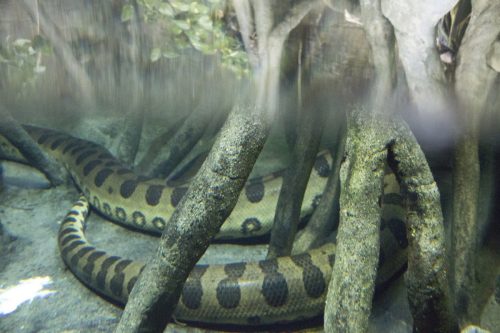
If the thought of 200-pound Burmese pythons has already started twisting your stomach into knots, you probably won't like the most recent snake news. Scientists now believe an even bigger species could be breeding in the U.S., The News-Press in Fort Myers, Florida, reported on July 20.
According to the newspaper, scientists say that a colony of invasive green anacondas has possibly been established in the Fakahatchee Strand Preserve State Park, which is located near the city of Naples in Collier County, Florida.
Like the Burmese python, this is one of the largest snake species in the world, but female green anacondas can actually grow to more than 25 feet in the wild, according to USGS.
"These snakes also exhibit the greatest sexual size dimorphism of any terrestrial vertebrate," the USGS states on its website. "Breeding females are at least five times the size of breeding males."
RELATED: You're Now More Likely to Get Bit by Venomous Snakes—Here's Why, New Study Says.
Green anacondas are considered to be a predator to many animals.
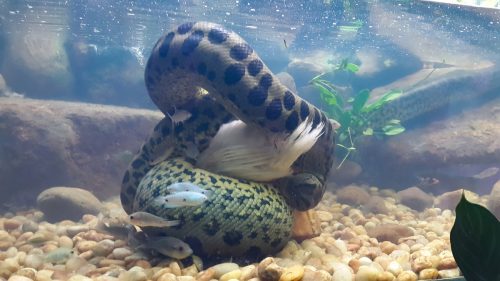
Green anacondas are the heaviest of the constrictors, and they will eat almost anything, The News-Press reported.
"The list of potential prey items of an anaconda is extensive and varied, and consists of birds, amphibians, reptiles, mammals, and fish," the USGS says.
And that's hardly the extent of their prey.
"Small individuals may climb trees to raid bird nests," the agency adds. "The green anaconda swallows its prey whole, even prey much larger than the diameter of their mouths. They are known to consume large prey such as peccaries, capybaras, tapirs, deer, and sheep."
RELATED: For more up-to-date information, sign up for our daily newsletter.
Researchers warn that these types of reptiles will continue to spread.
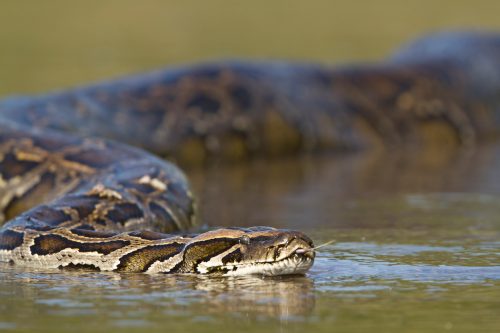
Invasive species of giant sizes—like 200-pound Burmese pythons and 25-foot green anacondas—threaten the ecosystems they invade and now inhabit. Researchers say that these creatures have the ability to wipe out medium-sized predators, such as foxes, raccoons, and opossums, from the food chain.
"This means that larger predators are missing a major food source, and the things that these smaller mammals feed on are going to have a population boom," Charles van Rees, PhD, a conservation scientist and naturalist at the University of Georgia, previously told Best Life.
He also added that specific species are particularly threatened, including an endangered rabbit found only in Florida that is "at risk of being snuffed out by excessive predation from this snake."
As more invasive snake species are located in the U.S., eradication becomes harder and harder—making it easier for these types of reptiles to continue to spread.
"If left totally unmitigated, this is very unlikely to remain a Florida problem," van Rees said. "The problem is absolutely going to grow if we don't do anything about it. And if eradication is no longer possible, smart investment right now can help keep this problem from spreading."
